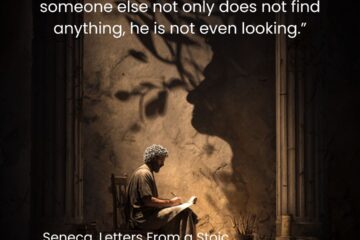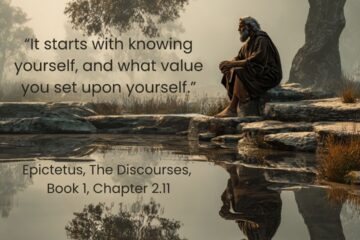
In Stoic philosophy, the concept of logos—universal reason—is central to understanding our place in the cosmos. While many look outward to comprehend this divine rationality, the path to understanding might be closer than we think.
Table of Contents
- Understanding the Stoic Logos
- The Internal Nature of Logos
- The Spectator Role
- Recognizing Universal Reason
- Practical Applications
- Finding Balance Through Internal Reflection
The Path to Universal Reason
When I think about or picture the Stoic Logos, instead of going to the grand cosmos, I tend to look inward. It is the micro rather than the macro where I search for the universal reason. In this post, I’d like to elaborate on my views and invite anyone with a different opinion to share them with me.
Scientists believe that the Big Bang started from a tiny point and worked itself outward. Like throwing a stone in a calm lake, the ripples would get bigger. That’s how I see the logical forces of nature work. As nature expands, its connections become more stretched. But when we dive into the quantum level of life, we will find that they are still strong.
Understanding the Stoic Logos
The Stoic Logos is the Rational universe which is pure reason and logic. It is found in everything and operates on cause and effect. We can refer to it as god, the divine, providence, and nature. But the concept of how the Stoics view the cosmos comes down to the above. They believe in a deterministic fate, where everything is already known. Yet we have been given a sliver of the logos to become the observers of the universe itself. It is here where we find our freedom. It’s either to accept this role or to deny it.
“Everything is interwoven, and the web is holy; none of its parts are unconnected. They are composed harmoniously, and together they compose the world.
One world, made up of all things.
Marcus Aurelius, Meditations, Book 7.9
One divinity, present in them all.
One substance and one law – the logos that all rational veins share.
And one truth…
If this is indeed the culmination of one process, beings who share the same birth, the same logos.”
The Internal Nature of Logos
“The world as a living being – one nature, one soul. Keep that in mind. And how everything feeds into that single experience, moves with a single motion. And how everything helps produce everything else. Spun and woven together.”
Marcus Aurelius, Meditations, Book 4.40

Marcus Aurelius states in this passage that it is all one. One nature and one soul, which is a sentence I love. Thus, we can ask ourselves whether an external or internal exists at all. And is it possible for one to exist without the other? Like a circle without either the interior side or the exterior one. For this to be so, we would need an infinite and borderless cosmos. Which is almost impossible to picture, but not an impossibility.
Yet, let us think of it as an infinite gathering of quantum particles that expands the entirety of the whole. Thus, the rational universe resides within each of our cells, atoms, and quarks, the same way it does in every other object and substance. Because we are closest to ourselves and observe the external world through our minds, to understand the Stoic Logos, we should focus on ourselves and our internal nature first. Everything we need to examine the cosmos is here for us to study.
The Spectator of God
More evidence that we should begin with an inward journey and understand the Stoic Logos within can be found in Discourse 1.6, where Epictetus states:
“But god has introduced man into the world as a spectator of himself and of his works; and not only as a spectator, but an interpreter of them.”
Epictetus, The Discourses, Book 1, Chapter 6.19
Not only are we trying to understand ourselves better, but even god or the Rational Universe is seeking to do so. If the Stoic Logos itself requires knowledge of what it is or isn’t, then we should possess a similar drive. But because observing and experiencing the world is our duty, we naturally drive toward an outward sensory ideal. To fulfill our duty as spectators, we must first make sure that our filters and lenses are free of obstructions.
Read more about the Stoic concept of God here.
We seek a false sense of connection by trying to please and make the opinions of the world around us more favorable. Forgetting that when we find that link to the world around us in the inner sphere, we will never be alone. We will be able to make a deeper and stronger connection with the Rational Universe because we carry it with us.
The Journey to Self-Knowledge

Socrates was so impressed with the inscription at the temple of Apollo in Delphi, “Know Thyself,” that this became a major theme in his life and philosophy. If our goal in life is to observe life itself, then we must start with the subject we know best, which is us. As we are undergoing the experience of life. Embracing this fact will allow us to find peace and harmony with our role in the cosmos. Accepting everything as it happens not as good and bad but as our task to observe it.
Finding Balance in the Cosmic Web
Although the Stoic Logos is most directly found within ourselves, we must not deny and forget the world around us. It is because of these connections and because it permeates everything, that we can’t deny the bigger picture that we are part of. We often see people struggle with where to begin. The amount of questions is limitless to the curious mind. And although there are a lot of unknowns out there, the most difficult questions we can ask are about ourselves. What better place to begin than where it is most difficult?
Only when we can confront ourselves and dive into the depths of our own mysteries can we remove the filters to the extent that we can observe the world around us more objectively. While I am a fan of science, exploring the unknown, and even space travel, we often lack the courage to examine our own minds. Diving into our flaws, mistakes, regrets, and failures can be painful, but only by examining them can we reveal our true nature.
Recognizing the Stoic Logos
While the Stoic Logos is all around us and finds itself deep in our core, it can be difficult to connect with it. The question then is how we can recognize this Rational Universe. For that, we have to go back to its essence. That is the information we need to learn to see it, or better yet feel it.
In Stoicism, we strive to reach a state called Eudaimonia, which can be translated to flourishing, excellence, or happiness. It can also be experienced as being at peace, where everything makes sense and is good. We can reach that state by being virtuous and living in accordance with nature. Recognizing this can be done by listening to ourselves and sensing whether we are at peace and calm. If we pursue the highest moral standards and keep our character as virtuous as possible, then our soul would be pure and we would feel at one with nature.
The Stoic Logos Within

The best place to find the answers you are looking for is close to home. Michel de Montaigne used himself as the main subject of his essays because that is what he was a true expert on. We will never know what is going on in the minds of others. There are still so many mysteries the cosmos holds for us, but we can try to understand ourselves as best as possible. By doing so, we will also find that the universe will become more familiar to us.
We might not be the center of the universe, but in a sensory and observant way, we are. We get to experience life firsthand, or better yet, we are the senses of god or nature. That’s why Marcus Aurelius reminds himself to get out of bed because that is his duty as a human being:
“At dawn, when you have trouble getting out of bed, tell yourself: ‘I have to go to work – as a human being. … So you were born to feel “nice”? Instead of doing things and experience them? …. And you’re not willing to do your job as a human being? Why aren’t you running to do what your nature demands?”
Marcus Aurelius, Meditations, Book 5.1
Do your duty and experience life. If you lack a sense of purpose, then focus on being a better person and experiencing all life has to offer. Everything that happens to us, whether we label it as good or bad, is an opportunity for us to learn what life is and to do the right thing.
If you are looking for support in finding more balance and harmony in your life, get in touch with our Stoic coaches and book a free consultation. Or you can listen to the Via Stoica Podcast and learn more about Stoicism there.


4 Comments
Laquita Richardson · 13/05/2025 at 10:59 pm
I’m trying to see what I’m really connected to,I have always felt a connection with the Universe so this really enlightened me
Benny Voncken · 14/05/2025 at 8:21 am
Thank you for your comment and I’m glad to hear that this helped you.
Benny Voncken · 02/10/2025 at 3:40 pm
Thank you for using and refering to my article on the Stoic Logos for your great post. If you need more resources or are looking for authentic Stoic quotes, our website offers many resources.
Logos: Od Wyrazu do Sensu – logoterapeuta.eu · 01/10/2025 at 2:46 pm
[…] The Stoic Logos: How to Find Universal Reason Within Yourself …, otwierano: września 17, 2025, https://viastoica.com/the-stoic-logos/ […]